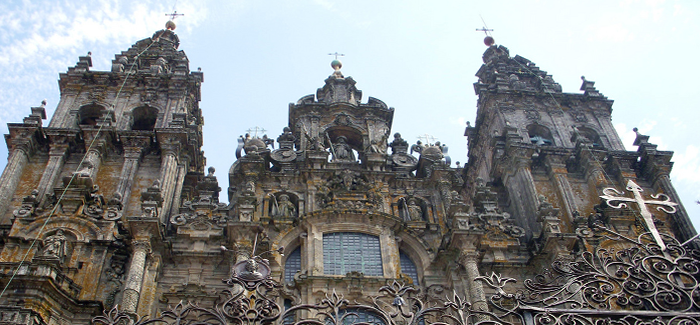
The medieval shrine of St. James in Santiago de Compostela has become the city’s massive cathedral. (Photography by bibliosopher, CC BY-NC-ND 2.0)
A Divinity School historian’s study of medieval Europe becomes a wellspring of historical fiction.
Traveling through northeastern Spain in 2003, Lucy Pick visited the church of Santa Maria in Santa Cruz de la Serós. An 11th-century Romanesque building, it stands along what was once a major pilgrimage route and originally served as a female monastery (a term that applied to both men and women) for daughters of the nobility. Pick, a medieval historian and Divinity School senior lecturer, explored the building’s mysteries, such as the big room above the altar whose purpose isn’t clear in historical records.
Pick was also exploring something else: a book of historical fiction that had been simmering in her imagination for years and that would allow her to “fill in the gaps” that history left open.
In July the novel, Pilgrimage, was released. Published by Cuidono Press, started by Martha K. Hoffman, AB’87, whose own PhD is in history, the novel takes readers on a journey with Gebirga, a blind woman, during the early 12th century. Gebirga travels from Flanders to the Spanish city of Santiago de Compostela, whose shrine—now a cathedral—was a major destination for pilgrims as the burial place of St. James the Apostle. The novel, Pick says, tries to “get into the skin of the an ordinary medieval person and to see their religious attitudes from the inside out.”
Gebirga, Pick’s protagonist, synthesizes two historical clues. The first: a passage in the medieval manuscript Codex Calixtinus, containing a pilgrim’s guide to Santiago de Compostela, which traced the route from southern France to the holy city. The passage lists as one of book’s authors a Gebirga of Flanders.
The second is the story of Saint Godeleva of Gistel, an 11th-century Flemish noblewoman. She was killed by her husband, and he was said to have had a blind daughter.
In Pick’s novel, Gebirga loses her sight at about three years old; the last thing she remembers seeing is an argument between her parents, which ended in the death of her mother, Godeleva, who is later beatified. When the reader first meets Gebirga, more than two decades have passed. With her father away in the Crusades, Gebirga has taken to running the household, and everyone expects that she will join the convent founded in honor of her mother, and which houses her sainted bones.
But through an accidental meeting with Katerinen, a count’s daughter, Gebirga instead embarks on a journey through France and into northern Spain. The women join a group of travelers heading toward Santiago de Compostela on the pilgrim road, including two clerics writing a guidebook and a mysterious messenger with an unknown agenda. Along the way Gebirga and Katerinen form a deep bond, and the pilgrims face danger, tragedy, and unexpected revelation.
As an undergraduate at Queen’s University in Ontario, Canada, Pick studied how women represented themselves in medieval treatises; she received a PhD in medieval studies from the University of Toronto in 1995. Her scholarly book, Conflict and Coexistence: Archbishop Rodrigo and the Muslims and Jews of Medieval Spain (University of Michigan Press, 2004), explores the dynamic between Muslims, Jews, and Christians in medieval Toledo, Spain.
Pilgrimage began stirring in 1997 while Pick was finishing a postdoctoral fellowship at the University of Chicago. The 2003 trip, which she took with her sister Elizabeth, a clinical therapist (“She is a person who listens to stories,” Pick says), helped propel the novel into being. Many of the medieval cities the sisters visited—Jaca, Loarre, and Santa Cruz de los Serós—appear in the book. The trip became, Pick says, “our own kind of pilgrimage.”
In their travels, they were drawn to stories of women. One was Countess Sancha Ramirez, whose tomb in Jaca is decorated with a relief showing her flanked by her sisters, who were likely also nuns in the monastery at Santa Cruz, which the countess helped promote. “We usually think of medieval women in relationship to men,” Pick says, “and here we have these women in relationship with each other.”
In Pilgrimage, Gebirga visits the church of Santa Cruz and traces her fingers across the relief on Countess Ramirez’s tomb (originally in Santa Cruz, it was later moved to Jaca, where Pick saw it), and she talks with the abbess about the possibility of Katerinen remaining there as a nun.
The endpoint of Gebirga’s pilgrimage, Santiago de Compostela, is a place where Pick has not yet been. Someday, she says. Compostela represents a pilgrimage’s end, and Pick is still in the middle of hers. Having finished a second historical novel, she’s working on a third. “I think what I want to do is to keep on the journey and see where it takes me next.”
